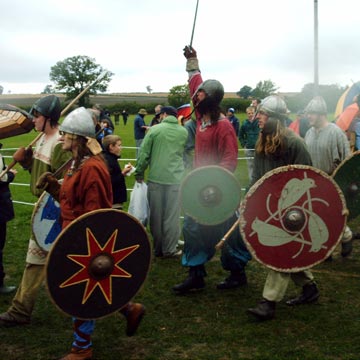What spurred the Viking invasions?
Reasons for invasion
The reasons for the Vikings expansion into other territories remain uncertain. They may be partly found in the general upheaval that followed the collapse of the Roman empire and the expansion of the Mongols into Europe that had brought the Saxons and Angles to Britain. To some extent tribes throughout Europe were being displaced and moving into new territory throughout the entire period from the departure of the Romans to the 11th century. Explanations in Wikipedia include:
- Overpopulation. Popularised by Peter Sawyer in 1971, (although he recanted this view in 1982) this is the view that the Vikings' interest was more in settlement than in raiding.However, there is no evidence of a rise in population or a fall in agricultural production at this time.
- Internal divisions in the targeted countries. This may have made their raids more successful but does not explain the surge to invade.
- Collapse of traditional trade routes after the fall of Rome, expansion of Islam and the Franks' destruction of the Frisian fleet. The Vikings were able to profit from the disruption and take over trading opportunities. Again, this explains how Viking trade could expand, but not why the Vikings felt compelled to expand their trading activities and does not explain the settlement or piracy.
"Bran the Explorer" argues, on the BBC h2g2 pages, for the interaction of trade motives, an available appropriately-developed naval technology and a cultural ethos that supported plunder. The members of a Germanic warband had to be rewarded, if their leader was to ensure their continued support. Heroic deeds, such as involvement in daring raids, also brought prestige to the band, in a culture that placed its highest value on warrior characteristics.
"Most authors also agree that economic growth promotes predatory activity as much as it does commercial activity; and in the maritime sector this means piracy." BBC

Attacks on England
Viking pirates first raided Portland in Dorset, in 787 AD, as recorded in the Anglo-Saxon Chronicle. Another pirate raid sacked the monastery in Lindisfarne in 793 AD. Raids continued for the next century, with Danish and Norwegian Vikings seizing land all over Northern England, as well raiding and settling in Scotland, the Isle of Man, part of Wales and Ireland.
There was a full-blown invasion of England in 865 AD, followed by several years of fighting between Saxons and Vikings. See pages on Alfred's resistance Some form of peace came when a division of England was agreed by the Treaty of Alfred and Guthrum, sometime arounfd 880 AD. England was split along a line following the ancient Roman Watling Street, from Chester to London, with the Danelaw to the north and the area ruled by the Saxons to the SouthDanelaw
Danish law, which was more or less compatible with Anglo-Saxon concepts, prevailed in the area ruled by the Danes. Five of the major important fortified towns in the Danelaw area were known as the Five Boroughs: Leicester, Lincoln, Nottingham, Stamford and Derby, all but one of which are still major towns of the current West Midlands
York was also an important settlement and is the source of the best surviving archaeological evidence of the Viking rule in England. Four Viking-Age house plots were excavated in York's Coppergate. These were single storey structures until the mid 10th century at least 7m (23ft) long by about 4.5m (14ft 9in) wide, with upright posts supporting a thatched roof and wattle and daub walls. Each house had earth floors and a central hearth. These houses are very similar to Anglo-Saxon houses of the same period and were not typically Scandinavian in design. From the 970s onwards, these buildings were replaced by two-storey buildings with cellars, also similar to the houses found throughout English towns during the period and suggesting, by their two-storey design, that there was increasing pressure on space in rapidly developing towns. There is a rich collection of artefacts, including ironwork, combs, wooden platters, and leather shoes.
References and Further Reading
- Wikipedia on The Viking Age .wikipedia.org
- Sawyer, PH The Causes of the Viking Age in Farrell, RT (ed.) (1982) The Vikings London: Phillimore
- Saxons and Vikings - The Pitkin Guide, ISBN 1841650420
- York's Jorvik Viking Centre